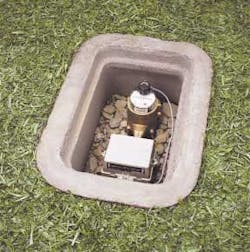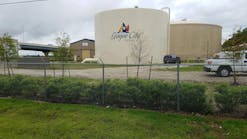Use of a hybrid battery pack for its MXU 505C meter transceiver unit permitted Sensus to offer a 20-year warranty for both system electronics and battery.
Click here to enlarge imageAs the water utility industry continues to migrate toward widescale use of Automatic Meter Reading (AMR) technology, the industry faces an ongoing challenge to make these installations increasingly profitable by extending the time between battery change outs.
With a current installed base of approximately 11.3 million units, the North American water utility AMR market is expected to grow by at least 20% over the next year, fueled by an ongoing demand to reduce labor costs associated with manual meter reading.
To realize such aggressive growth projections, AMR device manufacturers must continue to demonstrate to water utility customers that the initial investment costs associated with an AMR system installation can be cost justified by long-term savings. Issues related to long-term maintenance, including the costs associated with replacing batteries on a system-wide basis, factor heavily into this equation.
Self-Contained Power
In most cases, water utilities have limited options in terms of powering their AMR devices, with self-contained battery powered solutions being the preferred choice. Among primary battery alternatives, lithium thionyl chloride chemistry offers unique advantages to AMR applications, due to inherent advantages such as higher energy density, higher capacity, extended temperature range, and a service life that can exceed 20 years.
AMR meter design technology is rapidly evolving, with systems becoming increasingly feature-rich and power hungry. This trend, in turn, has pushed traditional lithium battery technology to its limits. Utility customers are increasingly demanding long-life batteries, recognizing that system-wide battery failures can lead to disrupted billing and costly service calls. This problem can be magnified by the fact that newer AMR devices often generate high current surges at periodic intervals, with little or no background current between signal transmission.
These high current pulse requirements have led to the development of a new hybrid lithium thionyl chloride battery technology, in which standard bobbin-type construction is combined with a unique Hybrid Layer Capacitor (HLC) to accommodate high current surges.
Chemistry
Lithium thionyl chloride cells feature the highest energy density and the highest open circuit voltage (3.6V) of any battery type. While the theoretical service life of a lithium thionyl chloride cell can exceed 20 years, the actual service life varies depending upon how the battery is manufactured. The service life of the battery is based largely on its self-discharge rate; which is governed by the cell's electrolyte composition, the production processes used in its manufacture, as well as mechanical and environmental considerations.
For example, a typical bobbin-type lithium thionyl chloride cell will deliver significantly lower self-discharge than a spiral wound lithium thionyl chloride cell of equal size. Self-discharge rate can be negatively impacted by high levels of impurities in the electrolyte. Extreme temperatures can also reduce battery performance, affecting both the voltage and self-discharge rate of the battery. As with all lithium chemistries, lithium thionyl chloride chemistry is non-aqueous, enabling these cells to withstand extreme temperatures, as low as -55∞C and as high as +150∞C in some cases.




